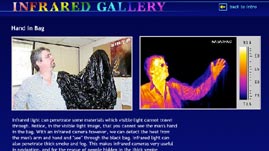Teachers' Domain - Digital Media for the Classroom and Professional Development
User: Preview

Source: NASA/JPL-Caltech
All objects emit infrared radiation -- the hotter an object is, the more intensely it radiates infrared wavelengths. Human eyes cannot see these wavelengths, but with the help of false-color imaging, temperature differences become visible and invisible features are suddenly illuminated. In this interactive gallery produced for Teachers' Domain, see what hydrothermal features and other objects look like in both visible and infrared light.
Visible light, the only type of light the human eye can detect, is just one small portion of the entire electromagnetic spectrum, which also includes radio waves, microwaves, infrared light, ultraviolet light, x-rays, and gamma rays. Infrared light lies just beyond the red range of visible light. It has lower energies and longer wavelengths, and is often associated with heat. With the help of scientific cameras and instruments, humans are now able to "see" in a variety of wavelengths outside the visible spectrum, and infrared light in particular is proving to be very useful in gathering data about Earth. For example, using remote sensing instruments carried onboard aircraft or orbiting satellites, researchers capture data in invisible wavelengths and are thus able to study Earth features and details that are imperceptible in visible light. Instruments collect the data and then translate the information into images that humans can see.
All matter emits energy. Objects at different temperatures emit energy at different wavelengths and of varying intensities. However, as long as the objects are at a nonzero temperature, they will all emit infrared radiation. By assigning different colors to infrared waves produced by different temperature ranges, false-color images of infrared radiation are created, allowing researchers to "see" temperature differences. Infrared light is also absorbed and reflected in distinct ways by different materials, which can provide additional images and spectral data.
Images showing temperature differences can be used to help understand many processes on Earth. Ocean currents and surface temperatures can be examined, leading to a better understanding of global climate change and weather patterns. Similarly, observations of cloud structures and movements can help with weather forecasting. Sensors that use infrared light can monitor vegetation density, crop health, oil spills, forest fires, and urban heat islands. Infrared radiation can also be used to examine the thickness of ice in the polar regions and to gather data to help explain how volcanoes erupt. In addition, infrared data helps to identify materials and determine the composition of soils, rocks, and gases. Remote sensing using infrared light is indispensable for gaining knowledge about Earth, as well as other planets, stars, galaxies, and interstellar dust.
 Loading Standards
Loading Standards Teachers' Domain is proud to be a Pathways portal to the National Science Digital Library.
Teachers' Domain is proud to be a Pathways portal to the National Science Digital Library.
